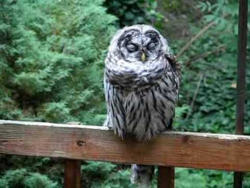 One of my big gripes with the present time, with freedom and democracy on the line, is that it delays consideration of other important issues.
One of my big gripes with the present time, with freedom and democracy on the line, is that it delays consideration of other important issues.
Like that of nature in the city.
We like to pretend that nature has been tamed in the city, that it has no place save what we carve out for it. This is false.
During this century, as exurbs have extended their tentacles to the deepest woods and the tallest mountains, we have seen an unprecedented, seldom remarked-upon, rush of animals to American cities. When I was raising chickens 20 years ago I only had to worry about opossums and raccoons. Now we have coyotes, hawks and falcons. We also have bunny rabbits, deer, armadillo and feral hogs roaming the local landscape.
 To some people any predator anywhere near their land, is a mortal threat. I often read threads at Nextdoor, a neighborhood-focused social site, complaining about the coyotes.
To some people any predator anywhere near their land, is a mortal threat. I often read threads at Nextdoor, a neighborhood-focused social site, complaining about the coyotes.
One complainant, whose home backs up on a piece of undevelopable bottom land, said he’d seen 3 coyotes at various times recently and threatened to shoot the animals, because he considered them a threat to his housecat.
Let’s pull that apart for a moment. No predator that could possibly take a housecat should be allowed to live. If this isn’t the very definition of insanity, well Trump me. Who’s going to kill the rats? Atlanta is one of the leading cities for rats, a key coyote food source. Are you going to take it on?
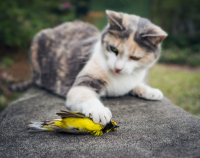 And about that cat. You know what’s killing all the songbirds, and bringing on the Silent Spring that Rachel Carson warned us about two generations ago? Kitty.
And about that cat. You know what’s killing all the songbirds, and bringing on the Silent Spring that Rachel Carson warned us about two generations ago? Kitty.
What this person was doing was what most of us do without thinking, prioritizing those animals that we like, that are cute, or that are good at hiding, over all other animals. We’re playing God, based on idiotic criteria.
This means favoring prey species like deer, which will reproduce to the limits of forage or predation, over anything that might limit their numbers. Deer are indeed overrunning our neighborhoods. It also means favoring species that are good at hiding, as well as reproducing, over other animals. Pigs, for instance. Georgia now has feral hogs growing to 1,000 pounds and more running around our suburbs. Hogs can reproduce several times a year, many hogs in each litter. We’re being overrun.
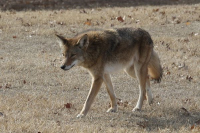 Because city dwellers like to play God, and because we do it so poorly, urban ecosystems are increasingly a mess. We don’t even have the data that would be needed to effect meaningful policy. We have no idea how many feral cats, rabbits, deer or coyote are nearby. No one seems interested in finding out. We don’t know how many deer, rabbits or armadillo in any area are too many. As a result, the rats and the deer and the pigs run wild. People complain, but there’s not only no policy, there’s nothing on which to base policy on.
Because city dwellers like to play God, and because we do it so poorly, urban ecosystems are increasingly a mess. We don’t even have the data that would be needed to effect meaningful policy. We have no idea how many feral cats, rabbits, deer or coyote are nearby. No one seems interested in finding out. We don’t know how many deer, rabbits or armadillo in any area are too many. As a result, the rats and the deer and the pigs run wild. People complain, but there’s not only no policy, there’s nothing on which to base policy on.
Policy can work. Again, two decades ago, our local MARTA station was being overrun by pigeons. They tried noise, they tried hanging plastic owls from rafters, they tried all sorts of things to deal with the shit. Nothing worked. Then someone remembered the Atlanta sports teams’ mascots. Hawks and Falcons were brought in, given aeries on some of our tallest skyscrapers, and now the pigeons are less of a problem.
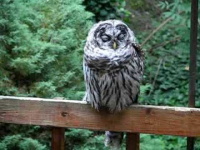 One reason I know so much about this is because my daughter has been studying it for most of the decade. She went for a wildlife management degree at Texas A&M Kingsville, where she was told we have too many park rangers in the countryside, not enough in the city. When she got back, she learned why. There’s no business model for employing park rangers in cities, no reliable source of funding. At least in the wilds of Texas you have bullet taxes from the NRA, the only source of government funding for wildlife conservation.
One reason I know so much about this is because my daughter has been studying it for most of the decade. She went for a wildlife management degree at Texas A&M Kingsville, where she was told we have too many park rangers in the countryside, not enough in the city. When she got back, she learned why. There’s no business model for employing park rangers in cities, no reliable source of funding. At least in the wilds of Texas you have bullet taxes from the NRA, the only source of government funding for wildlife conservation.
After getting a certificate in urban ecology in Atlanta, my daughter went to Europe last year to study the subject more closely, in Copenhagen and, soon, in Vienna. What she has learned is that there is an enormous divide, between those who, like my friend at Nextdoor, don’t acknowledge the problem, and those who think all animals are just wonderful and the solution is to eat rye crisps.
Somewhere there is a middle ground, where conservation principles can be applied, where data can be collected and deployed, and where reasonable policies concerning what to kill and what to preserve can be created. But the profession which will do that must be built from scratch. It doesn’t exist. She’s paying to learn things she may be unable to apply, which is scary for both of us.
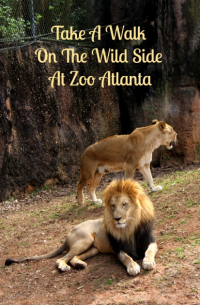 Another thing. Zoos. I like zoos. Zoo Atlanta gave my daughter her first taste of wildlife conservation half a lifetime ago. But zoos are a big part of the problem. Zoos put exotic animals in cages, which are called enclosures, but which are still cages. You’re separate from the wildlife for your own protection, and they from you.
Another thing. Zoos. I like zoos. Zoo Atlanta gave my daughter her first taste of wildlife conservation half a lifetime ago. But zoos are a big part of the problem. Zoos put exotic animals in cages, which are called enclosures, but which are still cages. You’re separate from the wildlife for your own protection, and they from you.
This does two things. First, it tells you that wildlife is something that happens somewhere else. Second, it distracts you from the wildlife going on all around you. While at a zoo I’ll often look around at the squirrels, birds, and other wild creatures making lives for themselves around the enclosures, or pigeons scouring the premises for peanuts, popcorn and other treats on which to raise their young.
My daughter has taught me that the real zoo is all around us. You live in a local ecosystem, even if you have an apartment in a Manhattan skyscraper. There may be a falcon nest right outside, a mother raising her kids on a diet of squirrel, pigeon, and maybe pizza slices dropped on the sidewalk. I’m also guessing there are rats in the crawlspaces, roaches behind the cabinets, and ants in the kitchen, all good food sources. You’re not killing them all. You’re just nurturing the next civilization, the one that will be here after Trump “blows up the world” and mankind becomes dust in the wind.
If you’re lower to the ground, the ecosystem is even more diverse. If you have a house with a yard, even more so.
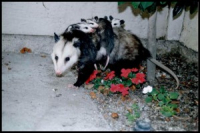 This is an ecosystem we need to nurture and cherish. It’s our responsibility. Ignoring it does nobody any good, not us and not the wildlife. We continue to destroy the wild places, the animals draw ever closer to our hearth fire, and they look to us as Gods, omnipotent creatures who decide which will live to reproduce, and which will die.
This is an ecosystem we need to nurture and cherish. It’s our responsibility. Ignoring it does nobody any good, not us and not the wildlife. We continue to destroy the wild places, the animals draw ever closer to our hearth fire, and they look to us as Gods, omnipotent creatures who decide which will live to reproduce, and which will die.
It’s time to take that seriously.









